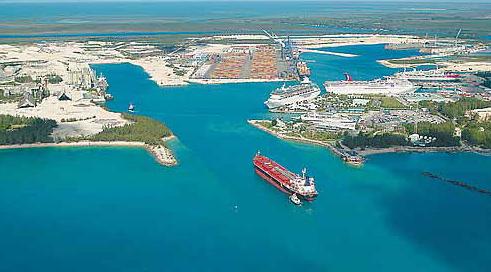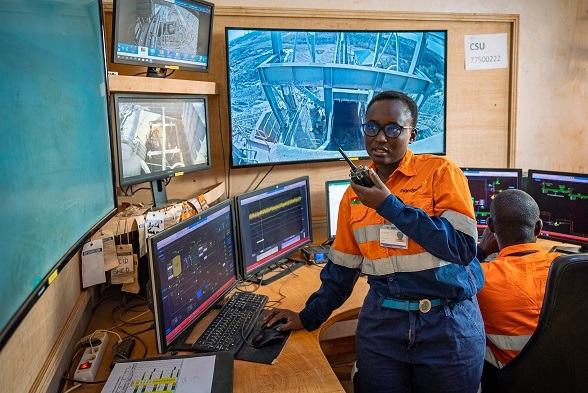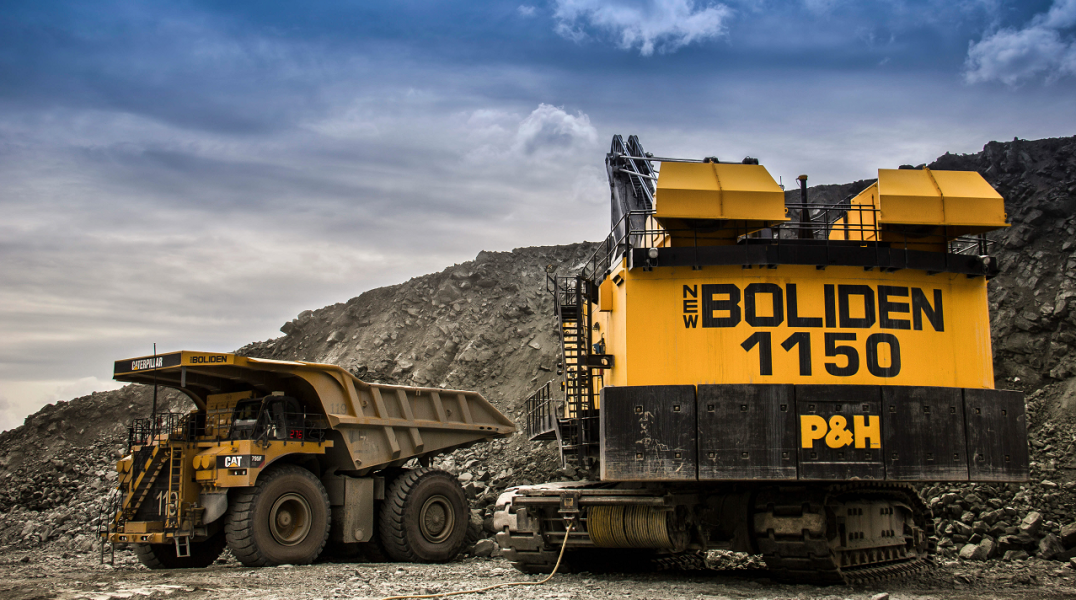
In the last five months, BORCO Terminals Bahamas has not only taken on a new identity as a subsidiary of the US energy company Buckeye Partners, but is in the process of expanding its capacity to meet future demand.
For many of us, the Bahamas are synonymous with pure white sandy beaches and luxury yachts. Consisting of a chain of 700 coral and sand islands and some 2,000 cays, they have been the holiday destination of the wealthy and famous for many decades. But the islands are much more than that. Located on the eastern edge of the Caribbean, just 45 miles (72km) off the coast of south east Florida, they occupy a strategic position in the main shipping lanes that link the southern USA and the Caribbean with destinations around the globe.
The islands’ importance in terms of shipping and industry dates back to the 1950s when American investor Wallace Groves and British financier Sir Charles Hayward pioneered the development of Grand Bahama Island as a tourist destination, and negotiated the visionary Hawskbill Creek Agreement with the Government of the Bahamas. Enshrined in law in 1955 the agreement created a free trade zone on Grand Bahama Island, not only giving rise to the city of Freeport but making its strategically critical port a huge success, and spurring the economic development and industrialization of the area.
Today, Freeport is the industrial heart of The Bahamas, and its port is globally important, particularly in terms of the economically crucial oil industry. One of the companies at the heart of this rapid development is BORCO, which operates the fourth largest oil and petroleum products storage terminal in the world. The company provides a massive 21.6 million barrels of storage capacity for crude oil, fuel oil and refined petroleum products and offers both build bulk and break bulk services for customers that range from major international as well as national oil companies through to trading companies and energy providers. The site at Freeport houses an extensive oil storage farm comprising some 80 tanks, and currently boasts three offshore jetties and an inland dock. With a total of 8 berths, the jetties and docks are designed to accommodate the largest ocean going vessels including those in the very large and ultra large crude carrier classes.
Originally set up as the Bahamas Oil Refinery Company, BORCO has undergone many phases of expansion, development and repositioning over the years. However, it wasn’t until 2008 when the company was acquired from Petroleos de Venezuela SA by a joint venture between the US private equity company First Reserve Corporation and world’s largest terminal operator Vopak, that the current format was clearly defined.
At the time of the acquisition, BORCO had already achieved the status of being the largest oil storage facility in the Caribbean with 73 oil tanks of different sizes and a total capacity of more than 3 million cubic meters. Following the acquisition, the facility was renamed Vopak Terminal Bahamas and was placed under the operational wing of Vopak. The aim was to operate the facility as an integral part of the Vopak global network, and to standardize its operational and commercial processes with those of the Vopak group. BORCO then underwent a period of redevelopment and expansion that resulted in the former refinery being positioned as an independent oil storage terminal with a capacity of 3.4 million cubic meters.
The story, however, has taken a new and exciting turn over the last seven months and has opened up a range of new opportunities for BORCO. In December 2010, US-based pipeline and storage terminal operator Buckeye Partners expressed an interest in expanding internationally, and acquired First Reserve’s 80 percent share in the company for a total of $1.36 billion, a figure which included First Reserve’s portion of the joint venture’s debt. This was closely followed by the acquisition of the remaining 20 percent share from Vopak, which brought BORCO under 100 percent ownership of the US energy company.
Buckeye’s original intention was to take over the operational responsibilities for the terminal by April 2013 when the current operating agreement with Vopak was scheduled to reach its end. However, by mutual agreement with Vopak the changeover has been accelerated. Operational control of the terminal has already been transferred to Buckeye, and Vopak has provided a range of transition services to enable Buckeye to assume control following a safe and professional handover.
This expansion into the eastern Caribbean has been Buckeye’s largest acquisition to date. Not only is BORCO the company’s single largest storage facility but it has become Buckeye’s flagship marine storage terminal. From BORCO’s perspective, the new business model and operational structure have resulted in some significant changes.
Buckeye is a midstream energy company that owns and operates one of the largest refined petroleum products pipeline systems in the United States. Its extensive network includes approximately 6,000 miles of pipeline owned by Buckeye in the Northwest and Midwest, and a further 2,700 miles of pipeline that the company operates on behalf of its customers. The company owns and operates more than 100 terminals which provide over 63 million barrels of liquid petroleum storage, and BORCO now plays a major part in this area of operations. However, the company offers a diverse range of services, and not only owns and operates a high performance natural gas storage facility in northern California, but also markets refined petroleum products in some of the regions served by its pipeline and terminal operations.
The takeover was finally completed in February 2011, and since that time, BORCO has been folding its operational and business processes into the Buckeye structure. From a reporting perspective, Buckeye manages performance across the organization through five business segments; pipelines & terminals, international operations, natural gas storage, energy services, and development & logistics. BORCO is the major player in the international operations segment, and operates alongside Buckeye’s liquid petroleum storage terminal located in Puerto Rico. The aim, going forward, is to explore and develop the synergies between BORCO and the Puerto Rico terminal, to the benefit of customers at both facilities.
BORCO has established an enviable position in the global oil industry, with the fourth largest oil and petroleum products storage terminal in the world. “We are a world class global logistics hub, ideally located very close to the Unites States,” explained company president, Raymond Jones. “One of the major factors contributing to our success is that we maintain a positive working relationship with the Bahamian Government as well as the Grand Bahama Port Authority, and this has enabled us to easily move forward with expansion projects, and to create additional jobs on the island.”
BORCO intends to continue developing its business and to benefit from synergies with its new parent company. Buckeye has acquired a vast resource of expertise in the North American marketplace, a pool of knowledge that the company hopes to be able to draw upon. “Buckeye is a best in class terminal operator and we hope to be able to benefit from additional support as well as integrating some of the Buckeye best practice into our operations,” Jones continued. “We also see some interesting opportunities to provide our customers with more product delivery options, particularly as patterns in the United States refining industry change over time.”
Over the previous few years under the First Reserve/Vopak joint venture, BORCO’s storage capacity had been increased by somewhere in the region of six million barrels. But Buckeye sees considerable opportunities for further growth at the Freeport site. Quick on the heels of the new takeover, the company announced that it would be investing a considerable amount in a phased expansion at Freeport, with the aim of advancing the terminal’s position as a key international hub for crude oil and petroleum product storage for the oil industry, and to cement its position as the best in class storage and trading platform for the region.
In the near term, Buckeye has given the go ahead for an initial expansion project costing in the region of $350-400 million which is designed to increase capacity by 7.9 million barrels, and this will be rolled out in several phases of development over the next two to three years.
The New York Stock Exchange-listed CB&I has recently been awarded the engineering, procurement, fabrication and construction contract to build the first phase of 14 new refined product and fuel oil storage tanks, and these are scheduled to come online during the second quarter of 2012. “We are also continuing to work on a project to complete an additional new berth at the inland dock,” said Jones. “Work is also progressing well on the installation of another deep water jetty comprising two further berths.” Further phases of expansion, planned as part of this near term project, will increase storage capacity by a further 4.4 million barrels.
Looking to the future, experts predict there is likely to be increasing demand for oil storage and terminal capacity. The rapid expansion of Middle Eastern and Asian refinery capacity is generating increased trade between the regions, making the BORCO terminal location even more attractive. Moreover, with fuel prices at their current level, there is an increasing demand for storage capacity. This combination of high customer demand, the high level of customer services provided by BORCO and the favorable location of the facility on the international shipping routes, place the company in a very advantageous position.
BORCO also benefits from having a considerable amount of unused land on the existing site, a luxury that many comparable organizations do not enjoy. If that land were to be fully utilized, the site could be developed to provide more than double its current storage capacity.
Meanwhile, the company is continuing to focus on achieving the top levels of quality and safety across the business. “Safety is a top priority for all Buckeye operations,” Jones said, “and this is not just with respect to our employees, but also for the communities in which we operate. We have several safety programs and training sessions, and we also hold safety and operational excellence summits each quarter.” Of course, while the words are easy to say, it’s the safety record that counts, and BORCO’s record speaks for itself. The company has recently completed one million man hours – which equates to 565 days in operation – without a single lost time accident.
From the environmental perspective, BORCO has always worked closely with the Department of Environmental Health Services and the Grand Bahama Port Authority to ensure its operations have the least impact on the delicate local environment. However, there is much it can learn from its new parent. Buckeye’s maintenance programs are based on a proactive approach. All the company’s assets are continuously assessed with the aim of identifying and removing potential hazards or concerns before an environmental incident can take place. The company has developed a range of internal best practice processes, working closely with the US Pipeline and Hazardous Materials Safety Administration, the oversight body for the relevant industry sectors. “We are now working to apply the same best practices here at BORCO,” said Jones.
Of course, it’s still early days yet and integrating a new acquisition into an established company is a long and complex process. There is still a great deal to do, but the benefits of the new and larger organization have already spread in both directions, benefiting both BORCO and Buckeye. Those benefits can only increase as the integration process progresses.
“The transition to Buckeye operations has been very positive so far,” Jones concluded. “We are excited to get BORCO’s near term expansion project under way and we look forward to remaining an integral part of the international midstream energy market.”
DOWNLOAD
 BORCO_AUG11_NA_BROCH_w.pdf
BORCO_AUG11_NA_BROCH_w.pdf













